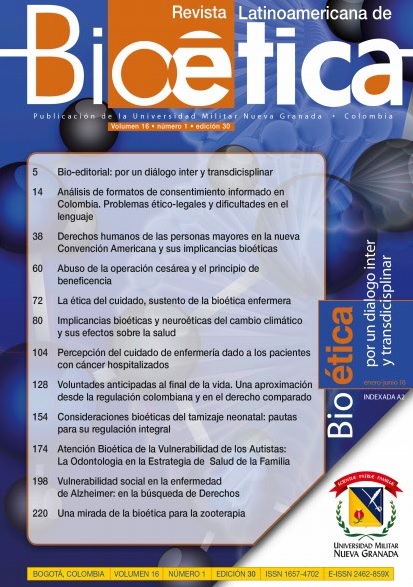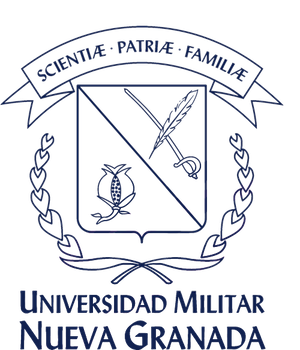Consideraciones bioéticas del tamizaje neonatal: pautas para su regulación integral
Resumen
El tamizaje neonatal pretende detectar al nacimiento anomalías susceptibles de tratamiento antes de la aparición de enfermedad. Su objetivo es evitar discapacidad e incluso la muerte de algunos recién nacidos. Con los desarrollos tecnológicos los beneficios se han extendido a la familia y a la sociedad. Contrariamente, también se han documentado daños psicológicos, sociales e incluso físicos. La probabilidad de daño está influenciada por consideraciones asociadas con principios bioéticos como la confidencialidad, la cual se relaciona con los principios de dignidad y autonomía. Aparecen entonces controversias como el tiempo de retención de muestras. De forma similar, hay otras controversias asociadas a consideraciones bioéticas como la prioridad de la persona o el consentimiento. A pesar del panorama descrito, la legislación no aborda de forma integral las consideraciones bioéticas. Colombia no es la excepción; la normatividad específica para tamizaje neonatal no considera ni siquiera de forma aislada consideraciones fundamentales en este tópico. En este contexto, el derecho blando da directivas como el deber de garantizar el acceso o las circunstancias en las cuales es posible realizar el tamizaje neonatal sin beneficio directo para el neonato. Sin embargo, no aborda otras consideraciones como el consentimiento y la confidencialidad, lo que amerita un debate bioético integral.
Descargas
Referencias bibliográficas
• Almond; B. (2006). Genetic profiling of newborns: ethical and social issues. Nat Rev Genet; 7(1); 67-71. doi: 10.1038/nrg1745
http://dx.doi.org/10.1038/nrg1745
• Beauchamp; T. y Childress; J. F. (2009a). Beneficence. En Principles of Biomedical Ethics (pp. 202-248). New York: Oxford University Press.
• Beauchamp; T. y Childress; J. F. (2009b). Nonmaleficence. En Principles of Biomedical Ethics (pp. 150-201). New York: Oxford University Press.
• Bermúdez; A. J.; Robayo; D. B.; Rosero; M. J.; Valera; D. A. y Gonzalez; Y. (2013). Situational analysis to implement expanded screening in Colombia. IX Latin American Congress of Inborn Errors of Metabolism and Newborn Screening; Medellin.
• Bunnik; E. M.; De Jong; A.; Nijsingh; N. y De Wert; G. M. (2013). The new genetics and informed consent: differentiating choice to preserve autonomy. Bioethics; 27(6); 348-355. doi: 10.1111/bioe.12030
http://dx.doi.org/10.1111/bioe.12030
• Burke; W.; Laberge; A. M. y Press; N. (2010). Debating clinical utility. Public Health Genomics; 13(4); 215-223. doi: 10.1159/000279623
http://dx.doi.org/10.1159/000279623
• Burke; W.; Pinsky; L. E. y Press; N. A. (2001). Categorizing genetic tests to identify their ethical; legal; and social implications. American Journal of Medical Genetic; 106(3); 233-240. doi: 10.1002/ajmg.10011
http://dx.doi.org/10.1002/ajmg.10011
• Campos; D. (2010). Neonatal screening by tandem mass spectrometry: an update. Revista Panamericana de Salud Publica; 27(4); 309-317. doi: S1020-49892010000400010 [pii]
• Chadwick; R.; ten Have; H.; Husted; J.; Levitt; M. et al. (1998). Genetic screening and ethics: European perspectives. Journal of Medicine and Philosophy; 23(3); 255-273. doi: 10.1076/jmep.23.3.255.2580
http://dx.doi.org/10.1076/jmep.23.3.255.2580
• Chase; D. S.; Tawn; E. J.; Parker; L.; Jonas; P. et al. (1998). The North Cumbria Community Genetics Project. Journal of Medical Genetics; 35(5); 413-416.
http://dx.doi.org/10.1136/jmg.35.5.413
• De Wert; G. M. (2005). Neonatal screening: dynamics and ethics. Ned Tijdschr Geneeskd; 149(51); 2841-2843.
• Dhanda; R. K. y Reilly; P. R. (2003). Legal and ethical issues of newborn screening. Pediatric Annals; 32(8); 540-546.
http://dx.doi.org/10.3928/0090-4481-20030801-11
• Edwards; E. S.; Bhutani; V. K.; Botkin; J.; Deloian; B. et al. (2008). Newborn screening expands: Recommendations for pediatricians and medical homes - Implications for the system. Pediatrics; 121(1); 192-217.
http://dx.doi.org/10.1542/peds.2007-3021
• Elliman; D. (2012). Ethical aspects of the expansion of neonatal screening programme due to technological advances. Clinical Chemistry and Laboratoy Medicine; 50(6); 999-1002. doi: 10.1515/cclm.2011.761
http://dx.doi.org/10.1515/cclm.2011.761
• Emaldi-Cirión; A. (2002). El consejo genético y la responsabilidad de los médicos que asesoran. Revista Latinoamericana de Bioética; 70-87.
• Farrell; M. H.; Christopher; S. A.; Tluczek; A.; Kennedy-Parker; K. et al. (2011). Improving communication between doctors and parents after newborn Screening. Wisconsin Medical Journal; 110(5); 221-227.
• Farrell; P. M. (2008). Is newborn screening for cystic fibrosis a basic human right? Journal of Cystic Fibrosis; 7(3); 262-265. doi: 10.1016/j.jcf.2008.01.001
http://dx.doi.org/10.1016/j.jcf.2008.01.001
• Goldenberg; A. J.; Dodson; D. S.; Davis; M. M. y Tarini; B. A. (2014). Parents' interest in whole-genome sequencing of newborns. Genetics in Medicine; 16(1); 78-84. doi: 10.1038/gim.2013.76
http://dx.doi.org/10.1038/gim.2013.76
• Gómez; A.I. (2010). Principios éticos y jurídicos del derecho genético en las declaraciones internacionales relacionadas con las intervenciones sobre el genoma humano. Vniversitas; (120); 141-168.
• Gurian; E. A.; Kinnamon; D. D.; Henry; J. J. y Waisbren; S. E. (2006). Expanded newborn screening for biochemical disorders: the effect of a false-positive result. Pediatrics; 117(6); 1915-1921. doi: 10.1542/peds.2005-2294
http://dx.doi.org/10.1542/peds.2005-2294
• Hardart; G. E. y Chung; W. K. (2014). Genetic testing of children for diseases that have onset in adulthood: The limits of family interests. Pediatrics; 134; S104-S110.
http://dx.doi.org/10.1542/peds.2014-1394f
• Helgesson; G.; Eriksson; S. y Swartling; U. (2007). Limited relevance of the right not to know-reflections on a screening study. Accounts of Chemical Research; 14(3); 197-209. doi: 10.1080/08989620701456322
http://dx.doi.org/10.1080/08989620701456322
• Hendrix; K. S.; Meslin; E. M.; Carroll; A. E. y Downs; S. M. (2013). Attitudes about the use of newborn dried blood spots for research: a survey of underrepresented parents. Academic Pediatrics; 13(5); 451-457. doi: 10.1016/j.acap.2013.04.010
http://dx.doi.org/10.1016/j.acap.2013.04.010
• Hernández-Álvarez; M. (2008). El concepto de equidad y el debate sobre lo justo en salud. Revista de Salud Pública; 10 sup(1); 72-82.
http://dx.doi.org/10.1590/S0124-00642008000600007
• Jonas; D.E.; Wilt; T.J.; Taylor; B. C.; Wilkins; T. M. y Matchar; D. B. (2012). Challenges in and Principles for Conducting Systematic Reviews of Genetic Tests Used as Predictive IndicatorsMethods Guide for Medical Test Reviews (pp. 1-17). Rockville: Agency for Healthcare Research and Quality (US). Recuperado de http://www.ncbi.nlm.nih.gov/books/NBK98231/.
• Kemper; A. R.; Green; N. S.; Calonge; N.; Lam; W. K. K. et al. (2014). Decision-making process for conditions nominated to the recommended uniform screening panel: Statement of the US department of health and human services secretary's advisory committee on heritable disorders in newborns and children. Genetics in Medicine; 16(2); 183-187.
http://dx.doi.org/10.1038/gim.2013.98
• Kerruish; N. J. y Robertson; S. P. (2005). Newborn screening: new developments; new dilemmas. Journal of Medical Ethics; 31(7); 393-398. doi: 10.1136/jme.2004.008219
http://dx.doi.org/10.1136/jme.2004.008219
• Lantos; J. D. (2011). Dangerous and expensive screening and treatment for rare childhood diseases: the case of Krabbe disease. Developmental Disabilities Research Reviews; 17(1); 15-18. doi: 10.1002/ddrr.133
http://dx.doi.org/10.1002/ddrr.133
• Lewis; M. H.; Goldenberg; A.; Anderson; R.; Rothwell; E. y Botkin; J. (2011). State laws regarding the retention and use of residual newborn screening blood samples. Pediatrics; 127(4); 703-712. doi: 10.1542/peds.2010-1468
http://dx.doi.org/10.1542/peds.2010-1468
• Lewis; M. H.; Scheurer; M. E.; Green; R. C. y McGuire; A. L. (2012). Research results: preserving newborn blood samples. Science Translational Medicine; 4(159); 159cm112. doi: 10.1126/scitranslmed.3004474
http://dx.doi.org/10.1126/scitranslmed.3004474
• Colombia; Congreso de la República (2000). "Ley 599". Recuperado de http://www.alcaldiabogota.gov.co/sisjur/normas/Norma1.jsp?i=6388
• Colombia; Congreso de la República (2010). "Ley 1392". Recuperado de http://www.alcaldiabogota.gov.co/sisjur/normas/Norma1.jsp?i=39965
• Loscalzo; J.; Kohane; I. y Barabasi; A. L. (2007). Human disease classification in the postgenomic era: a complex systems approach to human pathobiology. Molecular Systms Biololy; 3; 124. doi: 10.1038/msb4100163
http://dx.doi.org/10.1038/msb4100163
• Massie; J. y Gillam; L. (2014). Uncertain diagnosis after newborn screening for cystic fibrosis: An ethics-based approach to a clinical dilemma. Pediatric Pulmonology; 49(1); 1-7. doi: 10.1002/ppul.22933
http://dx.doi.org/10.1002/ppul.22933
• Matsuda; I. (2003). Bioethical considerations in neonatal screening: japanese experiences. The Southeast Asian Journal of Tropical Medicine and Public Health; 34 suppl (3); 46-48.
• Miller; F. A.; Robert; J. S. y Hayeems; R. Z. (2009). Questioning the consensus: managing carrier status results generated by newborn screening. American Journal of Public Health; 99(2); 210-215. doi: 10.2105/ajph.2008.136614
http://dx.doi.org/10.2105/AJPH.2008.136614
• Norgaard-Pedersen; B. y Hougaard; D. M. (2007). Storage policies and use of the Danish Newborn Screening Biobank. Journal of Inherited Metabolic Disease 30(4); 530-536. doi: 10.1007/s10545-007-0631-x
http://dx.doi.org/10.1007/s10545-007-0631-x
• Ortiz; T. (2008). Programa Nacional de Tamizaje y Diagnóstico Genético. Curso Continuo de Actualización en Pediatría; 7; 14-18. Recuperado de https://scp.com.co/precop/precop_files/modulo_7_vin_2/14-18%20Programa%20tamizaje.pdf
• Orzalesi; M. y Danhaive; O. (2009). Ethical problems with neonatal screening. Annali dell'Istituto Superiore di Sanita; 45(3); 325-330.
• President's Council on Bioethics (2008). The changing moral focus of newborn screening; an ethical analysis. Recuperado de https://repository.library.georgetown.edu/bitstream/handle/10822/559367/Newborn%20Screening%20for%20the%20web.pdf?sequence=1&isAllowed=y
• Raffan; E. y Semple; R. K. (2011). Next generation sequencing--implications for clinical practice. British Medical Bulletin; 99; 53-71. doi: 10.1093/bmb/ldr029
http://dx.doi.org/10.1093/bmb/ldr029
• Raho; J.A. (2008). The changing moral focus of newborn screening; an ethical analysis by the President's Council on Bioethics. Appendix newborn screening: an international survey. Recuperado de https://repository.library.georgetown.edu/bitstream/handle/10822/559379/the%20changing%20moral%20focus%20of%20newborn%20screening%20-%20appendix%20-%20joseph%20raho.pdf?sequence=1&isAllowed=y
• Richer; J.; Ghebremichael; M. S.; Chudley; A. E.; Robinson; W. M.; W. et al. (2011). Research use of leftover newborn bloodspots: attitudes of Canadian geneticists regarding storage and informed consent requirements. Genetics in Medicine; 13(4); 305-313. doi: 10.1097/GIM.0b013e3181f69da0
http://dx.doi.org/10.1097/GIM.0b013e3181f69da0
• Rose; N. C. y Dolan; S. M. (2012). Newborn screening and the obstetrician. Obstetrics & Gynecology; 120(4); 908-917. doi: 10.1097/AOG.0b013e31826b2f0300006250-201210000-00023 [pii]
• Sánchez; C. (2002). El derecho a la protección de la intimidad de los datos genéticos. Revista Latinoamericana de Bioética; 104-115.
• Schiffman; J. D.; Geller; J. I.; Mundt; E.; Means; A. et al. (2013). Update on pediatric cancer predisposition syndromes. Pediatric Blood & Cancer; 60(8); 1247-1252. doi: 10.1002/pbc.24555
http://dx.doi.org/10.1002/pbc.24555
• Schulman; A. (2008). The Future of newborn screening: clouds on the horizon? Recuperado de https://bioethicsarchive.georgetown.edu/pcbe/background/newborn_screening_schulman.html
• Strachan; T. y Read; A. (2011). Genes in pedigrees and populations. En Human Molecular Genetics (4ta. edición) (pp. 61-90). New York: Garland Science; Taylor & Francis Group.
• Tarini; B. A. (2007). The current revolution in newborn screening: new technology; old controversies. The Archives of Pediatrics & Adolescent Medicine; 161(8); 767-772. doi: 10.1001/archpedi.161.8.767
http://dx.doi.org/10.1001/archpedi.161.8.767
• Unesco (1997). Declaración Universal sobre el Genoma Humano y los Derechos Humanos. Recuperado de http://portal.unesco.org/es/ev.php-URL_ID=13177&URL_DO=DO_TOPIC&URL_SECTION=201.html
• Unesco (2003). Declaración Internacional sobre los Datos Genéticos Humanos.Recuperado. de http://portal.unesco.org/es/ev.php-URL_ID=17720&URL_DO=DO_TOPIC&URL_SECTION=201.html
• Unesco (2005). Declaración Universal sobre Bioética y Derechos Humanos. Recuperado de http://portal.unesco.org/es/ev.php-URL_ID=31058&URL_DO=DO_TOPIC&URL_SECTION=201.html











